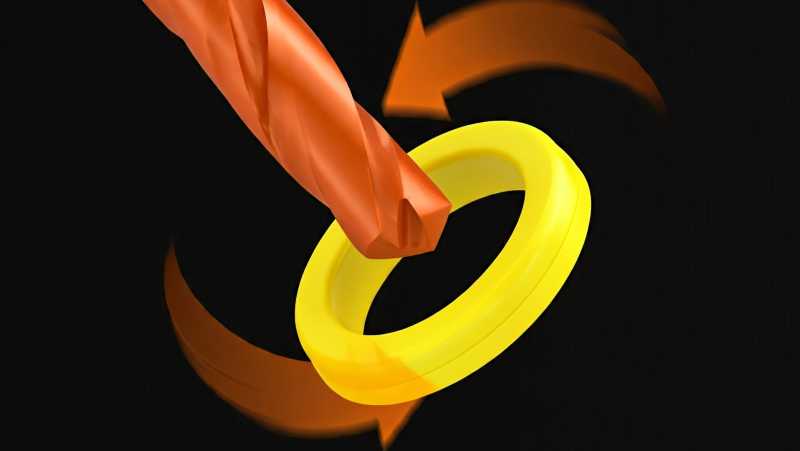Virtual Photons and Material Magnetism
Table of Contents
Magnetism is the combined effect of 3 Layers:
| Layer | Job |
|---|---|
| Spatial | Provides the force |
| Radiant | Guides and controls the force |
| Material | Provides the avenues for the force |
We define magnetism as the tendency for materials to attract and repel, independent of gravitation (which is the force of space particles on matter, using 2 layers only).
The Nature of Virtual Photons
Magnetic force comes from energetic virtual photons (mor3) that tunnel into channels, either in matter or non-media particles, to either repel or attract other matter.
These can be visualized like drill bits that rotate postively (anticlockwise).
This makes them look like corkscrews, exactly like how photons corkscrew.


These require specific receiver particles or channels that will let them through and transfer their rotation or force.
The major difference between photons and virtual photons is that photons are much larger. This is seen in the photo electric effect where high frequency light is able to push off electrons. This is because at high frequency, photons match the frequency of virtual photons. But instead of going through the electron to spin it, the electron is pushed away.

Unlike the force of material gravity which is caused by flowing space particles acting on natter, magnetic force is from the space particles that the virtual photons grab onto as they flow in and out of the channels.
Both photons and virtual photons travel in straight lines.
Dipoles
Virtual photons need channels for them to be concentrated and create visible and tangible effects.
This is because they are very small, much smaller than the space particles that cause spatial forces like gravity and magnetism.
Each channel has an entrance and exit, called poles.
A material magnet always has two poles, as dipoles, because that is the nature of a channel.
A radiant magnet, called a magnetic moment, also has diploes.
| Layer | Effect of Virtual Photon on Channel |
|---|---|
| Radiant, Convertible, Material Quanta | Spin |
| Material vom | North and South Poles |
Spin
The virtual photons transfer their spinning or corkscrewing energy to the channels that they pass through.
If they pass through electrons, then they make the electrons spin. These then release that energy upon hitting resistance such as the filament in a light bulb. This converts the electron spin into photon spin and heat particles.
Therefore, a light bulb is an example of virtual photon energy transfering into electron spin transferring into photon spin or light.
Virtual photons that go into metals do not make the molecules of the magnet spin.
But when they go through electrons, they make the electron spin. This is because the electron is independent unlike molecules which are fixed with other molecules.
The spin number is the ratio of virtual photons needed to rotate the electron or free particle.
1/2 spin means 2 virtual photons are needed to achieve 1 particle 360 degree rotation.
| Particle | Spin Number |
|---|---|
| Electron and Quanta | 1/2 (half-integer) |
| Substances | 3/2, 5/2 (half-integer) |
| Media | 1 (integer) |
Material Magnetism
Unlike the magnetic moment which happens in the channel inside a particle, Material Magnetism happens through channels in matter.
These allow far more virtual photons to flow through.
This is opposed to Electro Magnetism which requires electrons to organize themselves into channels.
We can say that:
- material magetism is static vortex magetism
- electromagnetism is dynamic vortex magnetism where in the spinning electrons create the channels on the fly
This is consistent with:
- material gravity coming from simple displacement of space particles
- orbital gravity coming from the dynamic rotation of a stellar-vortex
| Type | Radiant | Spatial |
|---|---|---|
| Dynamic Vortex | Electromagnetism | Orbital Gravity |
| Static Vortex | Material Magnetism | Material Gravity |
All magnetic forces, even material magnetism, originates from vortex magnetism.
Natural magnets are an example of material magnetism. These were magnetized when they were struck by lightning. This drilled channels into the ore, creating vortices.
Another example is the superconductor which are metals that have very straight channels.
Magnetic Attraction and Repulsion
Repulsion happens when the channels are opposed to each other. For example, when:
- an exit faces an exit
- an entrance faces and an entrance
Attraction happens when the chanels are aligned like when an exit is next to an entrance. This allows the virtual photons to keep on flowing.
This increases the magnetism by increasing the low pressure to a larger area.
We call:
- the exit as the male pole
- the entrance as the female pole